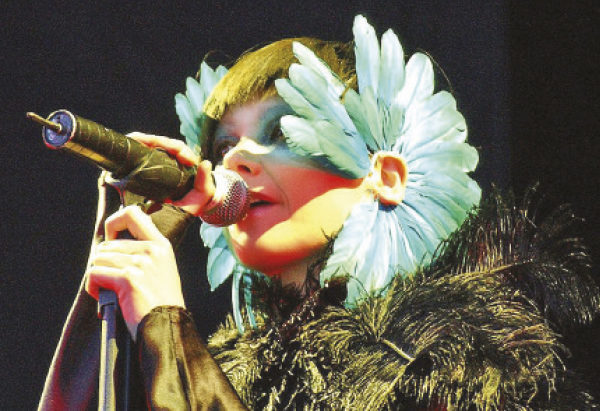
Photo courtesy Wiki Commons.
By Peter McNamara
The Cornucopia Tour has been billed by Björk as her “most elaborate staged concert to date”. Considering the fact that her Biophilia jaunt in 2011 utilised actual lightning to make beats, this is quite a claim. Then again, if any artist has shown a special gift at out-doing herself time and time again, it’s the irrespresible Icelander.
Sprung from her 2017 Utopia album, the Cornucopia show is another breathtaking display of Bjork’s creative bravery and self re-invention. From the raw punk of her early days, to the gleeful pop of her 1993 Debut, through to darker evolutions of Volta and Medúlla, Björk has always been unconfined by any label or genre. Now, along with the slew of collaborators that have brought this latest tour to fruition, she has once again reimagined her music and her persona.
With Cornucopia, Björk pushes the limits of what a live perfomance can acheive, and communicates a profound message about the beauty of nature, the need for climate action, and the wonderful possibilities for the future.
The Point Depot overflows
Directed by Argentine filmmaker Lucrecia Martel, the Conucopia tour began in May 2019, with an eight-night residency in New Yorkʼs The Shed. Its execution feels like a manifesto for the future of live music – and for music itself.
Fans at The Point were treated to a visually and atmospherically overwhelming production. The show is a rich embodiment of her Utopia album, involving a 50-piece choir, seven flautists and months of work by the cream of the sound, art, fashion and film worlds.
There was a fantastical, fungi-inspired set by theatre designer Chiara Stephenson. There were wild floral-aquatic-carnal visuals by artist Tobias Gremmler. Dancers and musicians chavorted in shimmering, structural costumes by Balmain and Iris Van Herpen.
Throughout the concert, vibrant colours of wild fungi trip and fold across the elabourate, mutli-tiered stage. Forest sounds flit through the arena. Gremmlerʼs visuals evoke the deepest oceans and the darkest cosmos, or mutate and invert the human form.
Visuals continually play tricks on the mind and eye. Anthropomorphic figures suddenly emerge from the darkness then fizzle into the ether just as quickly. A shoal of fish becomes a multitude of bristling petals.
And this wild and shifting presentation perfectly suits the music. Utopia as an album is all about finding a new paradigm – not just for Björk, as she reshaped her life after the breakdown of her relationship with Matthew Barney – but for all of us, in our ecological crisis.
As the message flashed up onscreen halfway through the gig reminds us, “We have to imagine something that doesnʼt exist, carve intentionally into the future. Make a musical mockup, then move into it.”
For ‘Show Me Forgivenessʼ, Björk conceals herself inside an ovoid vocal chamber designed for her by engineering firm Arup, to recreate the privacy in which she composes her songs.
A camera inside transmits her image on to the ribboned gauzes that frame the stage as she lets loose vocally, creating a weird paradox of intimacy and exposure.
Itʼs a potent effect on ‘Features Creaturesʼ, a painfully vulnerable song about peering at a new world through the afterimage of old love.
‘Body Memoryʼ, ‘Utopiaʼʼs darkest depth, is introduced by an incredible, body-and-brain-shaking sub-bass tone created by an 800lb organ pipe. Here comes an unsettlingly powerful practical lesson in the physicality of sound, and a reminder of one’s place within a fragile human form.
This bass-tone frequency ripples through your chest, through your entire body, like a powerful alien touch. And yet it causes not pain: I kept expecting the overwhelming sound to hurt my ear drums, and it didn’t. Here is another unique experience in a concert of firsts.
The overflowing show is fluid and seamless. And, even when cloaked in blossoming flowers, or surrounded by crashing CGI bodies, Björk remains your main focus. Undercutting the showʼs streamlined spectacle is her anarchic spirit.
A baby-faced Icelandic punk
Like the late David Bowie, Björk is an artist who riles against definition. As soon as her work seems comprehesible, she dives to the essence of what inspires her, and re-emerges as someone new. And, like Bowie, her musical talent is matched only by her instinct for chossing the right collaborators. She’s worked with the some the world’s greatest fashion designers, photographers, music producers, and directors.
Björk Guðmundsdóttir was born on November 21st 1965, in Reykjavic, Iceland. She was thrust into music school aged five, and quickly became frustrated. The “retro, constant Beethoven and Bach” bored her so much she’d regularly get called into the principal’s office.
She was offered an album deal after a teacher sent a recording of her singing to a radio station. Björk’s mother said yes on her behalf. The resulting folk-disco collection went platinum and made her a star. It was 1977. She was eleven years old.
Resenting being pushed into the pop spotlight, she turned down the chance to record a second album, instead writing her own songs, and working in a fish factory.
Her punk band Tappi Tíkarrass (whose name I won’t translate) went on to tour Europe. In 1986 they performed on Icelandic TV, with a heavily pregnant Björk baring her belly. This was too much for some viewers.
In 1992 she moved to London and went solo. Debut appeared in 1992, and was a worldwide smash. She followed this up with Post in 1995. This more dramatic album gave Björk her peak commercial success, as well as an uncomfortable level of fame.
Magazine covers and high-profile relationships came with airport meltdowns and letter bombs from stalkers. The musician moved to Málaga, to flee the glare and concentrate on the music, ramping up the intensity.
A futurist queen
Her 1997 album Homogenic featured lush cinematic soundscapes, gorgeously blended strings and electronica. By employing Alexander McQueen to design the cover, she killed off her kooky pixie image in one fell swoop. “I explained to him the person who wrote these songs —someone who was put into an impossible situation, so impossible that she had to become a warrior,” she told the Chicago Tribune at the time. “A warrior who had to fight not with weapons, but with love.”
In 2000 Björk starred in Lars Von Trier’s Dancer In The Dark. Her relationship with the contraversial film-maker wasn’t rosy. Legend has it she got so upset working with him that she ate her cardigan.
After the film Björk retreated to Iceland to make Vespertine. Appearing in 2001, it was an introverted ode to domestic bliss and her new-found love with artist Matthew Barney. The swan dress (by Marjan Pejoski) she wore on the cover designed to reflect Vespertine’s wintery theme, was the same one she wore for the 2001 Oscars, where she also, casually, laid an egg on the red carpet. “It’s just a dress,” said Björk.
She got in trouble with both the Serbian and Chinese authorities after on stage support for, respectively, Kosovo independence and freedom of Tibet during Volta’s shouty rave anthem “Declare Independence.” After Volta’s shenanigans, she stripped right back for the generally minimalist Biophilia (2011), which she composed on a touchscreen tablet.
For all her perceived affectations, Björk has never faked anything: she means it all. She’ll always sound—and look —like the future. And, as the Cornucipia show came to an end in Dublin, her sights were once again set on the way ahead.
We listened to the final song of her main set fade, and from out of her conjured natural utopia came a stark message: a specially-recorded video from Swedish environmentalist, Greta Thundberg.
The generous outpouring of the Cornucopia show reminds us that, although our future is surely threatened, there is still so much to gain in the century to come.



